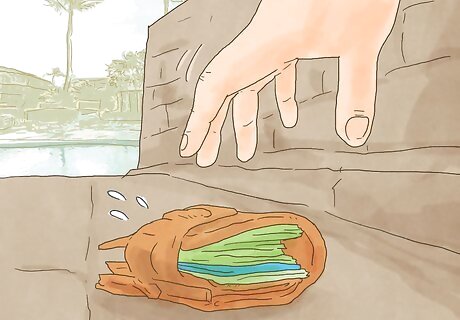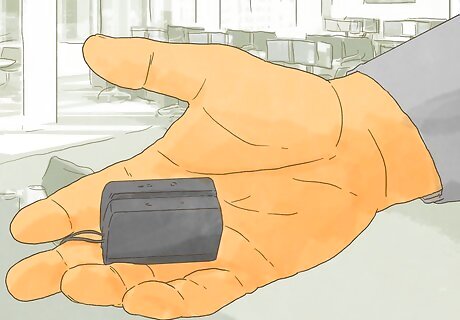
views
Keeping Your Information Current

Change your address or other contact information through your credit card issuer. Your bank or credit card company will allow you to change your contact information either through their website or over the phone. Use the customer service number printed on the back of your card to call your credit card issuer. If changing this information online, you will likely need to look for a section of the website marked “Change Address/Phone Number” or something similar. Use the “Help” or “FAQ” section if you can’t figure out how to do it. Bear in mind that you will need to have an online account already set up with your credit card issuer to change your address over the Internet. Capital One’s option for changing your address can be found on their customer service page. Discover provides instructions for changing both your address and name on their site. American Express’ system for changing your contact information works similarly to Capital One’s.

Update any subscription-related billing information online using the website of the organization to which you subscribe. Most websites that need your credit card information on file will have a “Billing” section where you can update your credit card info if necessary. Such changes can range from adding a totally new card to simply updating your current card’s expiration date. Either look for the site’s billing section or go to the “Help” section to find it. When changing your payment information on iTunes, remember that if you have Family Sharing turned on you will need to have your Family Organizer update the information. Netflix allows you to update payment and address information on the same page. You can manage your Amazon shipping and billing addresses in between purchases or while you are in the process of making a purchase. If your account is disabled because your card expired, updating the card will generally cause your account to be re-activated. If you use a debit card for subscriptions, the process of changing them is the same as it is for changing credit card-related information.

Try calling any organizations or products to which you subscribe to change your billing info. Most organizations that require your credit card to process recurring payments will have a hotline that you can call to change the information related to the card they have on file for you. In some cases these hotlines will operate 24 hours a day, 7 days a week. In other cases they will only operate during business hours, such as 8am through 5pm, Monday through Friday. Check the organization’s website for a help line. This information is usually listed at the bottom of the main webpage or under the “Contact” page.

Change recurring billing information through the mail through your monthly statement. If you receive a confirmation of payment in paper form each month, your statement should include a section where you can update your credit card information by filling in the appropriate fields by hand. Fill out these fields and send the statement back through the mail.

Obtain the correct documentation for a legal name change to your credit card. If you need to change your name for a reason such as getting married, you’ll need to file official paperwork with your state of residence before you can change the name on your credit card. This is because credit card companies will generally require official documentation such as a copy of your government-issued ID displaying your new name before they can make the change. The process varies by state, but generally you will need to file for a new Social Security card as well as driver’s license or other ID before you change the name on your card. Because the process of legally changing your name is different depending on the state in which you reside, you should contact your local court clerk to determine the specific requirements. In Virginia, for instance, you need to fill out official paperwork with the county court before going to the DMV and utilities to change the name on your official documentation.
Protecting Your Credit Card

Contact your bank immediately if your credit card is lost or stolen. Banks and other credit card companies often have specialized hotlines you can call 24 hours a day, 7 days a week, to report a lost or stolen card. U.S. federal law limits your liability for any unauthorized charges on your card to $50, and most credit cards come with policies that leave you liable for no unauthorized charges at all. But those policies usually only apply to purchases made after you report the card as lost or stolen. So if you wait until someone starts using your card in a fraudulent manner, you may be liable for $50 worth of purchases you didn’t make. Contacting your bank immediately is especially critical if you have a debit card. If you report the card missing between 2 and 60 days of when it was lost or stolen, you may be liable for up to $500 worth of unauthorized purchases. If you wait more than 60 days, you may be liable for all unauthorized purchases made during that time. The process for replacing a lost or stolen debit card is the same as it is for replacing a credit card. But be aware that you may be without a debit card for up to a week while you wait for a new one. That would mean you wouldn’t be able to withdraw cash from your bank account during that time. You can generally find the correct number to call if your card is lost or stolen on your most recent credit card statement. If you have online access to your card’s account, many banks and credit card companies will allow you to report the loss or theft online.

Use as much detail as possible to report a lost or stolen card. Details like where you last remember possessing the card, as well as the last purchase you remember making, are critical in any communication with your bank or credit card company. You may also need to provide the operator with your Social Security number or your credit card number.

Review your credit card statement every month for unauthorized purchases. A thief who steals your credit card information may make a small purchase of $20 or less to see if you notice. If you don’t dispute that charge, the thief may make bigger and bigger charges. A common variety of this scam is to place a charge of $9.84 on your card, as this value is small enough to avoid detection while also appearing legitimate. Remember that in some cases legitimate charges may show up under different names on your credit card statement. Therefore, don’t dispute charges that seem fraudulent without at least doing an internet search for the name under the charge. In some cases the charge may come with a phone number, which you should consider calling to ask about the charge.

Dispute unauthorized charges immediately. Use the customer service number located on the back of your card. Your credit card company may require you to contact the merchant first to ask them to cancel the charge. If they do, keep records of your communication with the merchant such as copies of emails or phone records to prove that you called them. Otherwise the credit card company will likely just cancel your card and replace it. Consider contacting the police to report an unauthorized charge first. Your credit card company may need a police report to find you not liable for the charge, and credit card fraud is a serious crime in any case.
Avoiding Scams

Don’t give identifying information to anyone who calls or emails you claiming to represent your credit card company. Credit card and identity thieves frequently pose as representatives of credit card companies to trick people into giving up sensitive information. This technique is known as "phishing." Only give out such information during calls that you initiate.

Shred everything sensitive. Most office supply stores sell inexpensive cross-cut shredders. These turn documents into tiny scraps of paper, unlike strip-cut shredders, which turn documents into long strips of paper that a thief can potentially re-assemble. Use a cross-cut shredder to destroy anything with your credit card number on it.

Create strong passwords if you access your credit card account online. Don’t use the same password for everything and don’t use weak, easily-guessed passwords like “guest,” “password,” or your birthdate. Use a combination of letters, numbers, and special symbols like @, !, and $. Keep your passwords safe by using a password manager or by writing them down and keeping that piece of paper in a secure location.

Keep your card secure. Don’t carry your card by itself in your pocket, where it might easily fall out or be stolen. Don’t leave your card exposed longer than necessary, as thieves might take a picture of it. If you carry your card in a purse, make sure your purse is zipped tight unless you’re removing something or placing something in it.

Watch out for credit card skimmers at gas stations. Credit card thieves sometimes install machines that read your card information onto card readers at gas stations. These machines, known as “skimmers” then transmit that information to the thief. If anything looks strange about a gas station credit card reader to you, contact the clerk or manager of the gas station.


















Comments
0 comment